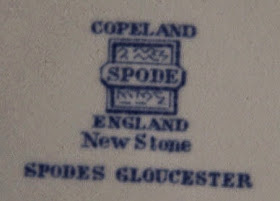This is a stone china body. For more information please look under Fine Stone on the F page and Stone China on the S page...
 |
| New Stone backstamp c1822-1833 |
 |
| New Stone backstamp c1920-1960 |
Ohio
Click on Ohio for my Spode and Ohio blog where you will find information about this shape.
Old Bailey (The)
Find out about Spode II's tussle with criminals as reported in the Old Bailey records - click here.
To further search this fantastic archive of criminal proceedings at the famous court please go to the Old Bailey Online - click here.
Olsen, Eric
 |
| Leaflet, 1933 |
The company minutes of 23rd April 1940 record that Olsen was appointed as 'Designer and Modeller...' with the 'responsibility for new designs and shapes and the maintenance of all shapes now being manufactured to their original standards. His salary to be increased to £6 a week exclusive of war bonus from 1st April 1940'. Olsen excelled at modelling rather than surface design. He is best remembered for his animal figures. These were produced in the Royal Jade and Velamour glazes. More on Velamour can be found on my T-V page.
Velamour was an earthenware body with a cream coloured matt glaze introduced in about 1932 and produced until 1940 and then from c1953 until 1969. A promotional pamphlet from this period explains 'The texture of the smooth matt glaze gives it a quality of its own avoiding the glare and crude reflections emitted by the bright glazes ordinarily employed.'
Royal Jade was a matt green glaze produced from about 1932 until 1938 - an image of a leaflet is illustrated. Some were also produced in Onyx introduced in 1932 - a grey body with a clear glaze. (See Onyx entry in this page). Although very beautiful it did not appear to be commercial and neither Onyx nor Royal Jade were made after the 1930s.
 |
| Spode 'Onyx' Greyhound designed by Olsen from Mats Linder |
Although the company did not encourage their designers to promote themselves as individuals Olsen's reputation was growing. In 1936 he was selected as a National Register Designer by the English Board of Trade and in 1937 an exhibition of his studio type wares in London was opened by the Queen of Norway.
Spode archive papers show he was also known as Erling Olsen and there are details in a report of his visit to Scandinavian Potteries following his holiday in Norway in August 1938. In 1942 Olsen left the Spode company to join the Norwegian Quartermaster General where he was a camouflage expert. After World War II he emigrated to the United States where he became chief designer at Haeger Potteries in Illinois.
Update 2016: for more information on Olsen please click here for Mats Linder's wonderful 'Scandinavian Design' website.
Olympus
Click here for my Spode and The Olympics? blog where you will find a bit more information on this 20th century pattern designed by Harold Holdway.
 |
| Detail of the central design of Olympus pattern |
Onyx
Onyx is both a pattern name and a body but unconnected with each other.
 |
| Onyx pattern |
 |
Backstamp, Onyx vase shape K17
|
From memory I cannot think of ever seeing a leaflet or catalogue for Onyx so include a page from a leaflet for Velamour from the 1930s where you can see a range of shapes including K17 mentioned in the backstamp image for Onyx. The K prefix denotes a shape number which were recorded in a series of K books an explanation of which is on my K page.
 |
Velamour vases. Some were also
made in Onyx and Royal Jade
|
To read about my research into Spode, Bateman and orchids please click here.


